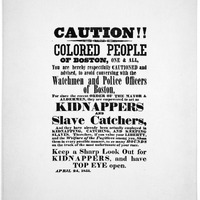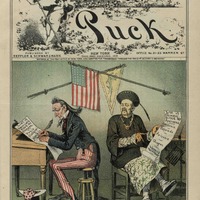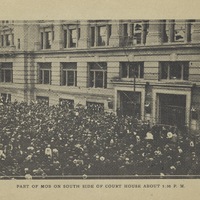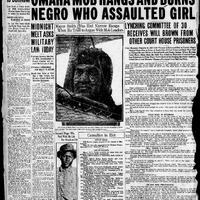 Broadside Reacting to the Fugitive Slave Act (1851) Broadside Reacting to the Fugitive Slave Act (1851) |
|
This broadside was distributed in Boston following the passage of the Fugitive Slave Act of 1850.
|
 Criminal Docket, Sweetwater County Rock Springs Precinct, September 1885 Criminal Docket, Sweetwater County Rock Springs Precinct, September 1885 |
|
A Coroner’s Inquest investigated the murders of Chinese mine workers in Rock Springs, Wyoming Territory, in September 1885. While 16 white miners were arrested for participation in the massacre, no one was ever held legally responsible.
|
 Enforcement Act of 1870 Enforcement Act of 1870 |
|
The Enforcement Act of 1870 was enacted to enforce the 15th Amendment during Reconstruction. It explicitly prohibited the use of terror, force, or disguise to violate a voter's constitutional right. This law was intended to protect the voting rights of Black Americans and penalize state officials and violent groups like the Ku Klux Klan who interfered.
|
 Enforcement Act of 1871 Enforcement Act of 1871 |
|
The Enforcement Act of 1871 revised the Enforcement Act of 1870 to further protect Black Americans' right to vote and hold office. It added more severe punishments to those who violated the constitutional rights of Black Americans. This act specifically called for federal oversight of national elections and empowered federal judges and marshals to supervise local polling places.
|
 Estimate of Property Loss Sustained by the Chinese in their respective camps at Rock Springs (1885) Estimate of Property Loss Sustained by the Chinese in their respective camps at Rock Springs (1885) |
|
In the wake of the 1885 Rock Springs Massacre, a U.S.- Chinese commission made up of politicians, ambassadors, and diplomats arrived in Wyoming Territory to collect testimony and tally the loss of property among Chinese laborers. The property lists accounted for individual property ownership, as well as property held in common by the Chinese miners.
|
 Executive Order 14053 - Improving Public Safety and Criminal Justice for Native Americans and Addressing the Crisis of Missing or Murdered Indigenous People (2021) Executive Order 14053 - Improving Public Safety and Criminal Justice for Native Americans and Addressing the Crisis of Missing or Murdered Indigenous People (2021) |
|
This executive order by President Joe Biden sought to improve the federal government's response to the public safety and criminal justice crisis of murdered and missing Native Americans.
|
 George Quander versus the Law (1897-1908) George Quander versus the Law (1897-1908) |
|
George Quander was the nephew of Felix Quander. Like his uncle, George had run-ins with Fairfax County officials, culminating in 1908, when he was shot and killed by a deputy sheriff serving a warrant. The Alexandria Gazette is unsympathetic in its coverage of George Quander's encounters with the court, its officers, and the racist white citizens of Fairfax County.
|
 Grover Cleveland Speech Regarding Chinese Immigrant Workers (1886) Grover Cleveland Speech Regarding Chinese Immigrant Workers (1886) |
|
President Grover Cleveland's 1886 speech discusses the anti-Chinese violence at Rock Springs, Wyoming Territory. In it he argues that the United States is not responsible for this violence.
|
 Keeping Account (1885) Keeping Account (1885) |
|
This political cartoon, published in the wake of the Rock Springs Massacre that targeted Chinese laborers, depicted the practice of "indemnity," or compensation between nations in the wake of racial violence. The cartoon depicted Uncle Sam and the Emperor of China debating how and whether China would be compensated for the racial violence in Wyoming Territory.
|
 Letter from Thirteen Choctaw and Chickasaw Freedmen Pleading for Federal Assistance in Emancipating their Kin (1865) Letter from Thirteen Choctaw and Chickasaw Freedmen Pleading for Federal Assistance in Emancipating their Kin (1865) |
|
This letter, formulated by a group of thirteen men who fled enslavement in the Choctaw and Chickasaw Nations, details how Choctaw and Chickasaw enslavers continued to hold Black people in bondage. The letter includes a plea for federal assistance in ensuring the freedom of the authors' family members, an exhibit with the names and locations of eighty people who were still enslaved in the Choctaw and Chickasaw Nations, and an accounting of how self-emancipated Black people were under threat of immediate death if they were to return to either nation.
|
 List of Freedmen who have been Murdered in the state of Texas since the close of the Rebellion (1866) List of Freedmen who have been Murdered in the state of Texas since the close of the Rebellion (1866) |
|
These records document the extreme extent of retributive, white supremacist violence committed against the population of freedmen and women upon emancipation in Texas. This compilation contains graphic language and descriptions.
|
 Memorial of Chinese laborers resident at Rock Springs, Wyoming Territory (1885) Memorial of Chinese laborers resident at Rock Springs, Wyoming Territory (1885) |
|
Over five hundred Chinese survivors of the 1885 racial violence in Rock Springs petitioned Huang Sih Chuen, the Chinese consul at New York, providing testimony of the white-led massacre and detailing the circumstances through which they lost property. Survivors demanded bodily protection and property compensation, while invoking recent treaty stipulations between the U.S. and China
|
 More Than a Snapshot: Will Brown's Lynching and the Violence of History More Than a Snapshot: Will Brown's Lynching and the Violence of History |
|
This teaching module discusses the history of racial violence in the Midwest, featuring a webinar with Ashley Howard, author of the 2025 book, Midwest Unrest: 1960s Urban Rebellions and the Black Freedom Movement.
|
 Omaha Grapples with its Ugly Past (2019) Omaha Grapples with its Ugly Past (2019) |
|
This article looks at the legacy of the lynching of Will Brown, featuring interviews with prominent, Black Omaha community members Preston Love and Ernie Chambers, as well as University of Nebraska-Omaha Urban studies professor, Barbara Hewins-Maroney.
|
 Omaha's Riot in Story & Pictures (1919) Omaha's Riot in Story & Pictures (1919) |
|
This series of photographs document the race riot in Omaha that culminated in the lynching of Will Brown in front of the Douglas County Courthouse. In the first, as many as 20,000 people gather outside an already damaged courthouse. In the second, white rioters smile around the remains of the police car they had set ablaze. And in the third, federal troops guard the intersection of 24th and Lake streets, an area with a large number of Black homes and businesses.
|
 Racial Violence at Rock Springs, Property Compensation, and "Indemnity" during Chinese Exclusion Racial Violence at Rock Springs, Property Compensation, and "Indemnity" during Chinese Exclusion |
|
This teaching module investigates the legal concept of "indemnity" and property compensation in the wake of the Rock Springs Massacre, which targeted Chinese laborers in Wyoming Territory in 1885. When white miners attacked a Chinese labor community, Chinese survivors petitioned the New York consul and worked through diplomatic channels to demand redress. This module explores how the concept of "indemnity" relied on treaty obligations and was tied to property compensation during a moment when national legislation worked to further restrict Chinese immigration.
|
 Remembering a dark past, renewing resolve for the future (2019) Remembering a dark past, renewing resolve for the future (2019) |
|
This article from the Omaha World Herald describes Omaha's official observance of the 100-year anniversary of the lynching of Will Brown. Omaha Mayor, Jean Stothert, spoke at the commemoration calling Will Brown's lynching one of the darkest days in our history.
|
 Savanna's Act (2018) Savanna's Act (2018) |
|
Savanna's Act (also known as the Missing and Murdered Indigenous Women Act) addressed federal and tribal jurisdictional cooperation concerning issues of violence and disappearance in the Native American community. The law is named after Savanna LaFontaine-Greywind, a member of the Spirit Lake Nation of North Dakota who was murdered in 2017. The act was signed into law in 2020.
|
 Studying the Missing and Murdered Indian Crisis Act of 2019 Studying the Missing and Murdered Indian Crisis Act of 2019 |
|
This bill was introduced to authorize the Government Accountability Office to collect data and study the crisis of missing and murdered Native Americans. It did not pass into law, but was a part of a broader legislative effort to bring awareness to murdered and missing Indigenous People.
|
 Terry v. Ohio (1968) Terry v. Ohio (1968) |
|
Terry v. Ohio is the landmark Supreme Court case that established the basis for stop and frisk policies. These policies disproportionately affect Black people and lead to the disproportionate incarceration of Black Americans.
|
 The Lynching of Will Brown (1919) The Lynching of Will Brown (1919) |
|
The day after the lynching of Will Brown, the Omaha Bee devoted the first two pages of its edition to the racial terror violence enacted by a mob of white Omahans. The articles on these pages provide different perspective of the race riot, from the crowds cheering at the destruction of government buildings, to the alleged assault victim's shock at the incident. The newspaper also featured a list of victims of the mob.
|
 Webinar - Latina/os and Criminal and Immigration Law Enforcement (2025) Webinar - Latina/os and Criminal and Immigration Law Enforcement (2025) |
|
In this webinar, Professor Kevin R. Johnson of the University of California, Davis, discusses the history of criminal and immigration law enforcement of Latina/os in the U.S with Dr. Donna D. Anderson and her And Justice For All class.
|
 Webinar - More Than a Snapshot: Will Brown's Lynching and the Violence of History (2025) Webinar - More Than a Snapshot: Will Brown's Lynching and the Violence of History (2025) |
|
In this webinar, Professor Ashley Howard of the University of Iowa discusses racial violence in the Midwest with Dr. Katrina Jagodinsky and her Rights & Wrongs in American Legal History class.
|
 Broadside Reacting to the Fugitive Slave Act (1851)
Broadside Reacting to the Fugitive Slave Act (1851) Criminal Docket, Sweetwater County Rock Springs Precinct, September 1885
Criminal Docket, Sweetwater County Rock Springs Precinct, September 1885 Enforcement Act of 1870
Enforcement Act of 1870 Enforcement Act of 1871
Enforcement Act of 1871 Estimate of Property Loss Sustained by the Chinese in their respective camps at Rock Springs (1885)
Estimate of Property Loss Sustained by the Chinese in their respective camps at Rock Springs (1885) Executive Order 14053 - Improving Public Safety and Criminal Justice for Native Americans and Addressing the Crisis of Missing or Murdered Indigenous People (2021)
Executive Order 14053 - Improving Public Safety and Criminal Justice for Native Americans and Addressing the Crisis of Missing or Murdered Indigenous People (2021) George Quander versus the Law (1897-1908)
George Quander versus the Law (1897-1908) Grover Cleveland Speech Regarding Chinese Immigrant Workers (1886)
Grover Cleveland Speech Regarding Chinese Immigrant Workers (1886) Keeping Account (1885)
Keeping Account (1885) Letter from Thirteen Choctaw and Chickasaw Freedmen Pleading for Federal Assistance in Emancipating their Kin (1865)
Letter from Thirteen Choctaw and Chickasaw Freedmen Pleading for Federal Assistance in Emancipating their Kin (1865) List of Freedmen who have been Murdered in the state of Texas since the close of the Rebellion (1866)
List of Freedmen who have been Murdered in the state of Texas since the close of the Rebellion (1866) Memorial of Chinese laborers resident at Rock Springs, Wyoming Territory (1885)
Memorial of Chinese laborers resident at Rock Springs, Wyoming Territory (1885) More Than a Snapshot: Will Brown's Lynching and the Violence of History
More Than a Snapshot: Will Brown's Lynching and the Violence of History Omaha Grapples with its Ugly Past (2019)
Omaha Grapples with its Ugly Past (2019) Omaha's Riot in Story & Pictures (1919)
Omaha's Riot in Story & Pictures (1919) Racial Violence at Rock Springs, Property Compensation, and "Indemnity" during Chinese Exclusion
Racial Violence at Rock Springs, Property Compensation, and "Indemnity" during Chinese Exclusion Remembering a dark past, renewing resolve for the future (2019)
Remembering a dark past, renewing resolve for the future (2019) Savanna's Act (2018)
Savanna's Act (2018) Studying the Missing and Murdered Indian Crisis Act of 2019
Studying the Missing and Murdered Indian Crisis Act of 2019 Terry v. Ohio (1968)
Terry v. Ohio (1968) The Lynching of Will Brown (1919)
The Lynching of Will Brown (1919) Webinar - Latina/os and Criminal and Immigration Law Enforcement (2025)
Webinar - Latina/os and Criminal and Immigration Law Enforcement (2025) Webinar - More Than a Snapshot: Will Brown's Lynching and the Violence of History (2025)
Webinar - More Than a Snapshot: Will Brown's Lynching and the Violence of History (2025)